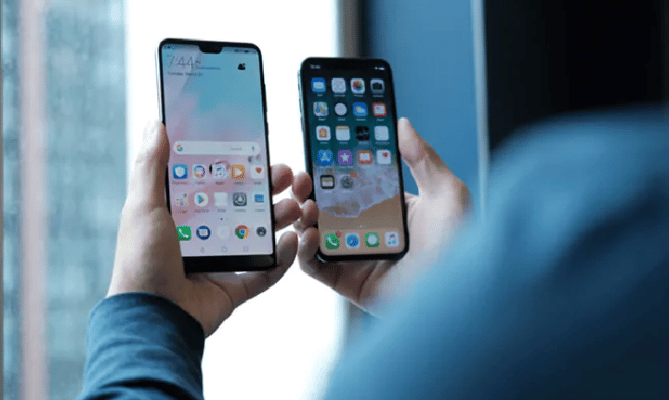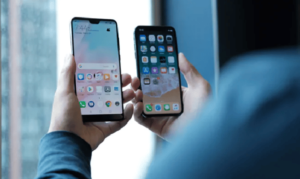You will find two types of displays across TVs, mobiles, laptops, computers, and more. If you are unsure which one is better and want to buy a gadget with a screen, you don’t have to worry. Here are OLED vs LCD panels for you to better understand the difference between them.
What you will see?
OLED vs LCD panels
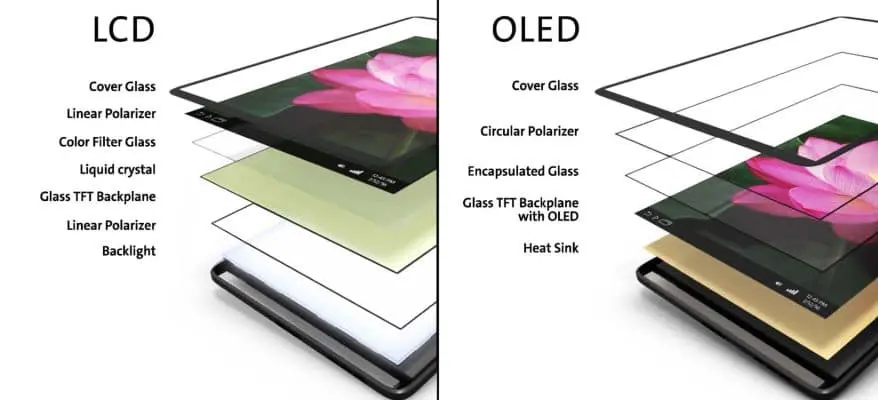
LED or the Light-Emitting Diode is the most prevalent type of display available. However, some consumers may not be familiar with it because LCD is sometimes mislabeled (Liquid Crystal Display). The two are identical for display purposes, therefore if a TV or smartphone claims to have a “LED” screen, it actually has an LCD. Just the lighting source is referred to as LED, not the display itself. OLED (Organic Light-Emitting Diode) is used in expensive flagship phones and TVs.
| LCD | OLED | |
| Thickness (TV) | Minimum 1 inch | OLED TVs are thinner because of the size of their diodes |
| Power consumption | Requires more power than OLED | Requires less power |
| Cost | Cheaper | Expensive |
| Mechanism | Backlight covered by a layer of liquid crystals | Organic Light-emitting diodes |
| Backlight | Yes | No |
| Used by | iPhone, HTC Sensation, iPad 2 | Samsung Galaxy S II, Samsung Galaxy Nexus, Nokia Lumina 800 |
| Contrast Ratio | Up to 15000:1 | 65000:1 – 1,000,000:1 |
| Energy consumption | Much greater | Less |
| Viewing angle | Up to 165°, the Picture suffers from the side | 170-degree viewing angle |
How do they differ?
OLED pixels generate their own light, in contrast to LED LCD panels, which rely on a backlight to illuminate their pixels. OLED pixels are sometimes referred to as “self-emissive,” whereas LCD technology is “transmissive.” A pixel-by-pixel approach can be used to regulate the lighting of an OLED display. An LED LCD cannot achieve this level of dexterity. However, there are disadvantages to this strategy. Edge lighting, in which LEDs are placed to the side rather than in front of the panel, is frequently used in less expensive TVs and LCD-screen phones using LED LCD screens. These LEDs fire light through a matrix, which feeds it through red, green, and blue pixels before entering the human eyes.
Brightness
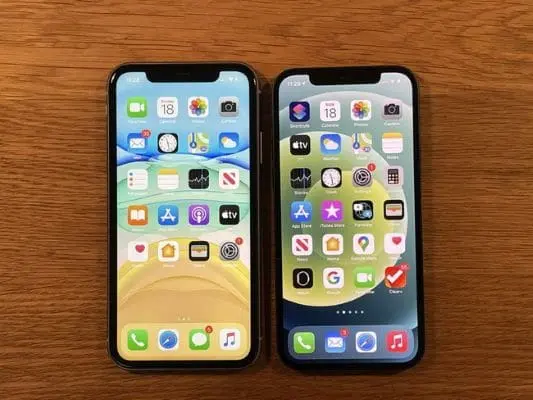
OLED displays can’t be as bright as LED LCD screens. That matters a lot in the realm of TV, but it matters even more for smartphones, which are frequently used outside in direct sunlight. Typically, brightness is expressed in “nits,” or roughly the amount of light emitted by a candle per square metre. High dynamic range video also benefits from brightness when being viewed in natural or ambient light. This is more relevant to TVs, but since phones have respectable video capabilities, it also matters in that market. The visual impact increases as the light level rise.
Contrast
In a completely dark room, you can see that in an LCD panel some areas of a completely black display aren’t truly black since the backlighting (or edge illumination) is still visible. Unwanted backlighting visibility has an impact on a display’s contrast. In a product’s specification, a contrast ratio is frequently mentioned, especially when it comes to TVs and monitors. This reveals the difference in brightness between a display’s whites and blacks. The contrast ratio of a good LCD display may be 1,000:1. This indicates that the whites are 1,000 times brighter than the blacks.
An OLED display has a much higher contrast. The pixels of an OLED panel creates no light at all when it is completely dark. That translates to an infinite contrast ratio, though how well it seems will depend on how bright the screen can get. In general, OLED screens work best when used in dimly lit spaces. Moreover, TVs are no exception to this rule.
Viewing Angles
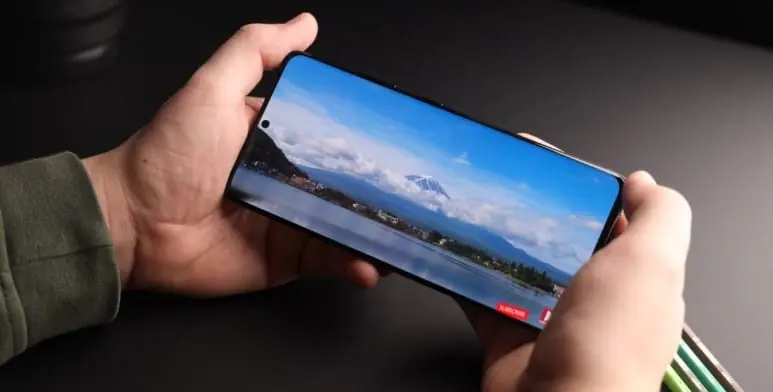
With the small technology and the pixels being so near to the surface, OLED screens provide exceptional viewing angles. You won’t lose contrast if you move about an OLED TV or spread out in different areas of your living room. Due to the fact that you don’t always hold your hand completely parallel to your face when using a phone, viewing angles are particularly crucial. Although this varies greatly depending on the display technology used, viewing angles are often worse in LCDs. Additionally, there are many distinct types of LCD screens. The most fundamental is Twisted Nematic, which provides poor angled viewing. It is utilised in low-cost phones, laptops, and computer monitors.
It’s highly likely that your computer screen employs a twisted nematic panel if you’ve ever observed that it appears all gloomy from a particular angle. IPS panels are widely used in LCD displays these days. In-plane switching typically offers greater colour performance and significantly increased viewing angles. Most smartphones, tablets and several computers and TV monitors employ IPS technology. It’s crucial to understand that IPS and LED LCD are not incompatible; this is just additional jargon.
How do the screens work?
LCD screens are lighted by a backlight and use liquid crystals that twist and untwist in response to an electric charge. They untwist to let through a certain quantity of light as a current passes through them. The display is then made by combining them using colour filters. Whereas, when activated by an electric current, organic carbon-based chemicals used in OLEDs produce coloured light.
Colour
The most recent LCD screens can provide brilliant, realistic-looking colours. However, it depends on the exact technology being used, just like with viewing angles. When calibrated properly, IPS and VA (vertical alignment) panels offer excellent colour accuracy. Although TN screens can appear weak or washed out. The brightness and vibrancy of OLED colours are less of an issue now. However, early OLED TVs and phones had trouble controlling and maintaining accurate colour. The situation is better now because Hollywood movies are graded on Panasonic’s premium OLEDs. OLED challenges in the area of colour volume. That is, maintaining levels of colour saturation on an OLED panel may be difficult in bright environments. It’s a flaw that manufacturers who support LCDs want to highlight.
Future for LCD and OLED
Display manufacturers are working hard to adjust and improve the different constraints of LCD. Both have recently been the focus of new developments. Quantum Dot and Mini LED are both used in LCD. The former makes use of a quantum-dot display using blue LEDs rather than white LEDs and “nanocrystals” of varying sizes to change the wavelength of light to create different colours. Although many TV manufacturers have adopted Quantum Dot technology, Samsung’s QLED branded TVs are the most popular. Mini LED uses smaller-sized LEDs that may emit more light than conventional ones, boosting the TV’s brightness output. Additionally, because they are smaller, screens can accommodate more of them. Thus, giving you more control over brightness and contrast.
The largest producer of large-sized OLED panels, LG has created Evo OLED panels that are brighter than earlier iterations. It employs a new substance (deuterium) for the blue OLED material layer inside the panel. This can last longer and have more electrical current passed through it, boosting the screen’s brightness and colour volume (the range of colours it can display). QD-OLED is another advancement. In order to increase brightness, colour accuracy, and volume while maintaining OLED’s perfect blacks, infinite contrast, and potentially even wider viewing angles, this display technology combines Quantum Dot backlights with an OLED panel.
So, even if viewers are dispersed throughout a room they see essentially the same image. In 2022 Samsung and Sony are introducing QD-OLED TVs. AMOLED (Active-Matrix Organic Light Emitting Diode) screens for Android smartphones are becoming more popular. Apple is moving toward OLED screens for its smartphones and experimenting with Mini LED with the iPad Pro. With the availability of Super and Dynamic AMOLED variants, technology is always improving and performance is being increased.
OLED vs LCD- Which one is better?
In comparison to LCD screens, OLED displays exhibit deeper blacks, better contrast ratios, and lower power usage. They are also more accurate in terms of color. Although, blue OLEDs have a shorter lifespan and are more expensive. However, LCDs are more widely available and typically far less expensive than OLED displays.
Advantages of OLED vs LCD screens
- OLED screens are incredibly lightweight.
- They provide a significantly wider viewing angle. In contrast, LCD panels have a restricted viewing angle. The quality of the image on an LCD panel is inconsistent even when the viewing angle is supported. Differences in the viewer’s posture cause fluctuations in brightness, contrast, saturation, and hue.
- A static contrast ratio of more than 1,000,000:1.
- More and richer colors, and a sharper image.
- Reduced power usage when dark colors are displayed.
- OLED panels are not restricted by geography. In contrast, LCD panels lose contrast in high-temperature settings while gaining brightness and speed in low-temperature settings.
- Extremely quick response speeds prevent display motion blur and the ghosting effect.
- OLED displays can be flexible, bendable displays.
Disadvantages of OLED vs LCD screens
- The “O” in OLED stands for organic, hence the display is susceptible to water damage.
- OLEDs that produce blue light deteriorate more quickly than those that produce other colors. Because of this, the manufacturers of these displays frequently make up for it by calibrating the colors in a way that makes them too saturated and gives the screen a bluish hue.
- Due to their higher manufacturing costs, OLED screens are more expensive than backlit LCD screens.
- When showing light colors, OLED displays currently require more energy than LCDs with backlights. OLED screens have lower whites than backlit LCD panels but have deeper blacks.
Common drawbacks of LCD and OLED displays
- Poor readability and display under bright ambient light such as outside in direct sunshine.
- It’s possible for some pixels to be faulty or to “stick” either during use or even the initial manufacturing process.
Conclusion
Although LED LCD has been around for a lot longer and is less expensive to produce, manufacturers are starting to shift away from it, at least in the sense of the ‘standard’ LCD LED displays. They are choosing instead to go for alternatives like Mini LED and Quantum Dot. OLED has gained popularity and gotten less expensive. OLED has far broader viewing angles than LED LCD. This is perfect for situations when a lot of people are watching TV at once. OLED is also much better at handling darkness and lighting accuracy.
Although there is a potential issue with image preservation, OLED also offers greater refresh rates and motion processing. If you have a tight budget, you’ll almost surely get an LCD-based screen whether you’re purchasing a phone, monitor, laptop, or TV. While still more expensive, OLED is becoming more widely used in TVs, laptops, some of the best smartphones, and handheld gaming devices. Both OLED and LCD LED have flaws. Some praise OLED for its illumination precision and ability to handle darkness. Others favor LCDs’ increased brightness and ability to keep colors vibrant. Whether you go with LCD or OLED, you can rest easy knowing that both technologies have advanced significantly, making now a secure time to invest.
OLED vs LCD: Which one do you prefer? Tell us in the comments section below.
Read More!
- Nintendo Switch OLED: Price, Release Date, and all other details!
- iPad Air Keyboard Case-Ultimate alternatives for your typing sessions!
- Dell XPS 15 OLED – Does it holds the reputation of its predecessor?
- Dyson Pure Cool Tower – An Ultimate Gadget to stay cool in summer!
- Best alternatives for Apple’s Magic Keyboard – Which one to buy?


